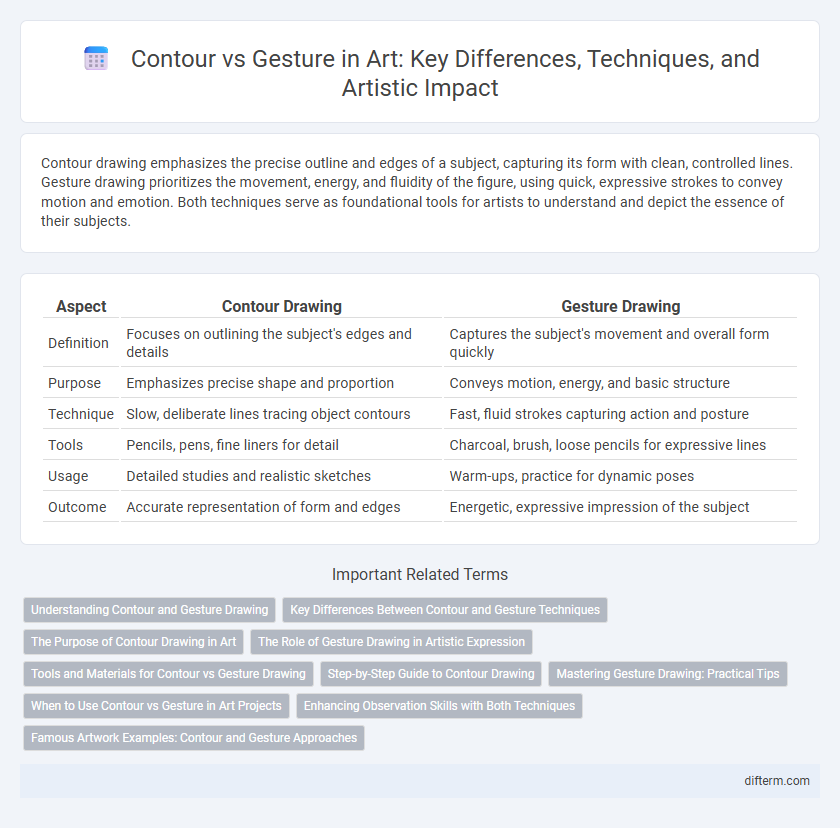Contour drawing emphasizes the precise outline and edges of a subject, capturing its form with clean, controlled lines. Gesture drawing prioritizes the movement, energy, and fluidity of the figure, using quick, expressive strokes to convey motion and emotion. Both techniques serve as foundational tools for artists to understand and depict the essence of their subjects.
Table of Comparison
| Aspect | Contour Drawing | Gesture Drawing |
|---|---|---|
| Definition | Focuses on outlining the subject's edges and details | Captures the subject's movement and overall form quickly |
| Purpose | Emphasizes precise shape and proportion | Conveys motion, energy, and basic structure |
| Technique | Slow, deliberate lines tracing object contours | Fast, fluid strokes capturing action and posture |
| Tools | Pencils, pens, fine liners for detail | Charcoal, brush, loose pencils for expressive lines |
| Usage | Detailed studies and realistic sketches | Warm-ups, practice for dynamic poses |
| Outcome | Accurate representation of form and edges | Energetic, expressive impression of the subject |
Understanding Contour and Gesture Drawing
Contour drawing emphasizes precise, continuous lines to capture the edges and surface details of a subject, enhancing observational skills and hand-eye coordination. Gesture drawing focuses on rapid, expressive strokes that convey the movement, posture, and energy of the figure, prioritizing fluidity over detail. Mastering both techniques deepens an artist's ability to represent form and motion, creating more dynamic and lifelike artwork.
Key Differences Between Contour and Gesture Techniques
Contour drawing emphasizes capturing the precise edges and outlines of a subject with continuous lines, creating a detailed and structured representation. Gesture drawing focuses on quickly expressing the movement, posture, and overall energy of the figure, often using loose, fluid strokes to capture the essence rather than the detail. The key differences lie in contour's attention to accuracy and fine detail versus gesture's prioritization of motion and dynamism.
The Purpose of Contour Drawing in Art
Contour drawing emphasizes capturing the precise edges and outlines of a subject to develop keen observational skills and hand-eye coordination. It trains artists to see and represent the form and structure accurately without relying on shading or color. This practice enhances an artist's ability to depict volume and spatial relationships, forming a foundation for more detailed and expressive artwork.
The Role of Gesture Drawing in Artistic Expression
Gesture drawing captures the fluidity and movement of a subject, emphasizing emotion and spontaneity over precise detail. This dynamic approach allows artists to convey the essence and energy of figures, fostering a deeper connection between the observer and the artwork. By focusing on swift, expressive lines, gesture drawing enhances artistic expression and informs more refined contour work.
Tools and Materials for Contour vs Gesture Drawing
Contour drawing emphasizes precision using fine-tipped pens, graphite pencils, or charcoal sticks to capture detailed outlines and edges, while gesture drawing relies on soft, broad tools like vine charcoal, compressed charcoal, or thick graphite to quickly convey movement and form. Smooth, heavyweight paper supports detailed contour work by allowing controlled strokes without bleeding, whereas textured or newsprint paper suits gesture drawing by facilitating rapid, expressive marks. Artists often select tools and materials that enhance the intended effect: contour drawings demand control and clarity, gesture drawings prioritize speed and fluidity.
Step-by-Step Guide to Contour Drawing
Contour drawing emphasizes precise line work to capture the edges and shapes of a subject, creating detailed and structured artwork. Gesture drawing focuses on quick, loose strokes to express movement and overall form, prioritizing energy over accuracy. A step-by-step guide to contour drawing involves observing the subject closely, slowly sketching continuous lines without lifting the pencil, and avoiding shading to enhance line quality and detail.
Mastering Gesture Drawing: Practical Tips
Mastering gesture drawing enhances an artist's ability to capture the essence and movement of a subject, emphasizing fluidity over precise contour lines. Practical tips include using quick, sweeping strokes to define action and posture, allowing spontaneous representation of dynamic poses. Developing this skill improves anatomical understanding and injects life into figure drawing by prioritizing motion and emotion rather than static outlines.
When to Use Contour vs Gesture in Art Projects
Contour drawing is best used when capturing precise shapes and details, emphasizing an object's edges and structure for a more realistic and defined representation. Gesture drawing excels in early stages of art projects, capturing the movement, flow, and overall form, which helps convey energy and dynamism. Artists often use gesture drawings to establish proportions quickly, then refine the artwork with contour lines to enhance accuracy and detail.
Enhancing Observation Skills with Both Techniques
Contour drawing sharpens observation by requiring careful attention to edges and shapes, improving hand-eye coordination and detail recognition. Gesture drawing captures movement and energy, fostering an intuitive understanding of form and dynamic posture. Combining both techniques enhances overall artistic perception, enabling artists to observe and represent subjects more accurately and expressively.
Famous Artwork Examples: Contour and Gesture Approaches
Contour drawing captures the precise outlines and details seen in Leonardo da Vinci's "Vitruvian Man," emphasizing form and proportion with deliberate line work. Gesture drawing reflects the dynamic motion and energy found in Edgar Degas' pastel sketches of dancers, using loose, expressive strokes to convey movement. These contrasting techniques highlight how artists balance structural accuracy and fluid expression in visual storytelling.
contour vs gesture Infographic

 difterm.com
difterm.com